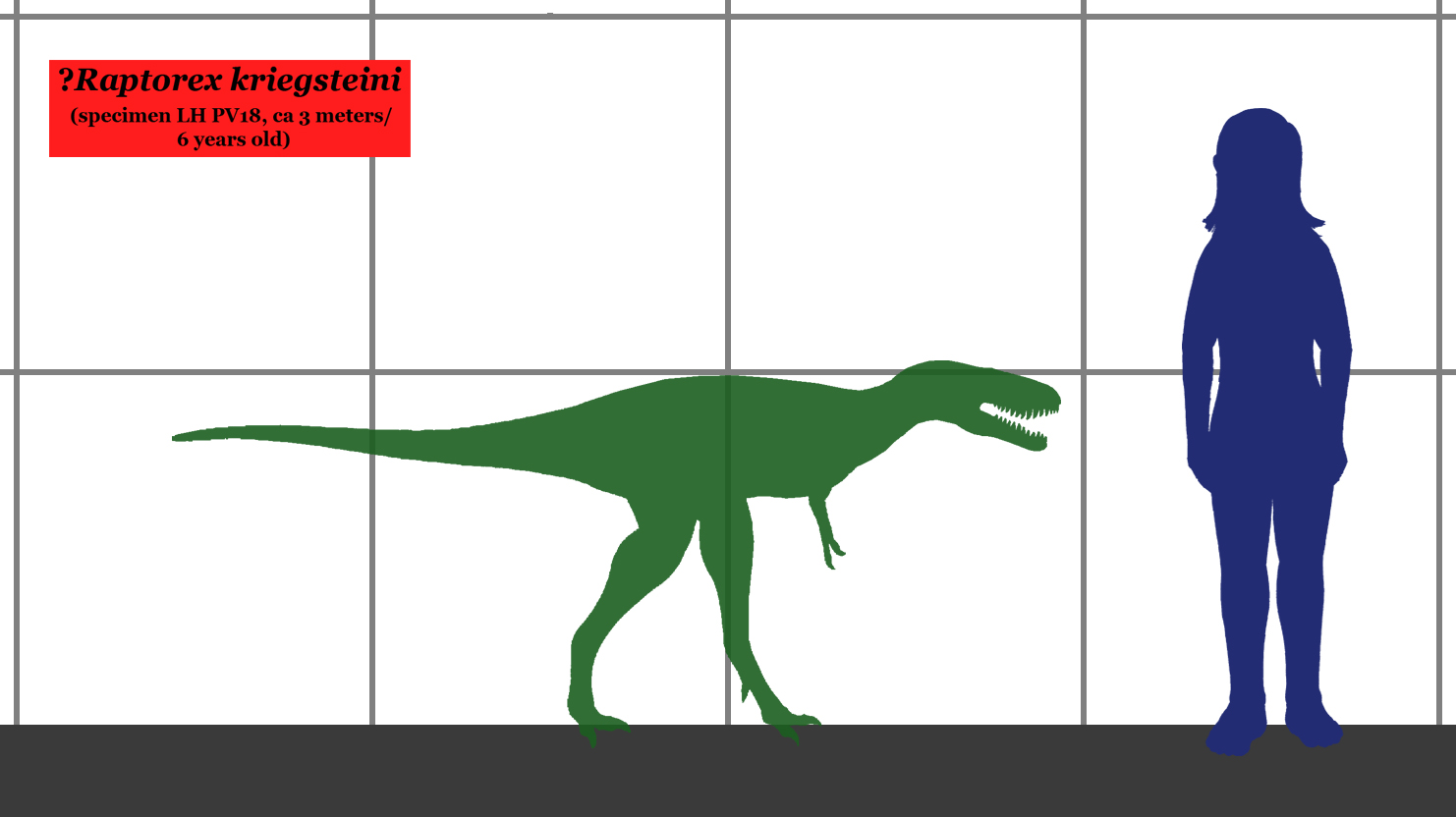But it wouldn't be long before these claims would be seriously challenged, ultimately reducing Raptorex to a nomen dubium.
 |
| Raptorex kriegsteini compared to a human (image by Conty, from Wikipedia) |
Raptorex kriegsteini was described by Paul Sereno as a new Tyrannosauroid from the early Cretaceous of China. The specimen was described as a young adult of 3 meters in length and an estimated weight of 65kg. In terms of size and weight that would be comparable to other Late Jurassic/Early Cretaceous Tyrannosauroids like Dilong and Guanlong. But it's bodyplan was radically different, Dilong and Guanlong were much closer to their Coelurosaurian ancestors, with long arms, three-fingered hands and a small head. Raptorex on the other hand was remarkably similar to Late Cretaceous Tyrannosaurids like Tyrannosaurus and Tarbosaurus.
This seemed at at the time to shed a new light on Tyrannosaur evolution, Raptorex was according to Sereno an intermediate stage between the small long-armed Tyrannosaurs and the large short-armed Tyrannosaurids.
A chequered past
The fossil that was described already had something of a history, it had already changed hands several times before being sold to Henry Kriegstein as a juvenile Tarbosaurus. Kriegstein had originally planned to use the fossil as decoration for his living room (money can't buy hapiness, but it can buy a genuine Tyrannosaur fossil!).
 |
| Raptorex skull and life reconstruction (with manes!) |
To date this suddenly new find Sereno used the fossil of a Lycoptera fish embedded in the same rock, which meant that it originated from the early Cretaceous. Sereno also speculated that the fossil had originally come from the Yixian formation in China, but had been smuggled to Mongolia for sale on the black market.
That was not the first U-turn in the identification of the fossil, before it was sold as a juvenile Tarbosaurus from Mongolia it had tentatively been considered an Alectrosaurus (a medium-sized Tyrannosauroid from the Late Cretaceous). Such differences is identification are perhaps unsurprising, identifying juvenile specimens is complicated. Like most Dinosaurs Tyrannosaurs underwent major changes to their body during growth, so a juvenile specimen might look very different from the adult form. Knowing the origin of the fossil would of course narrow things down, but that information is generally lost when the fossil is traded on the black market.
The gloves come off
| Raptorex skull (Conty) |
This led to a devastating conlusion:
Unless stronger evidence is presented, Raptorex should be considered a nomen dubium. LH PV18 [the Raptorex fossil] more likely represents the juvenile of a larger tyrannosaurid from the Late Cretaceous of Mongolia, such as Tarbosaurus.And with that "Raptorex" had come almost full-circle. Originally sold to Kriegstein as a juvenile Tarbosaurus it had enjoyed a brief period of fame as a totally new species of Tyrannosaur, but was once again provisionally identified as a juvenile Tarbosaurus.
Of course this is still a very tentative identification, there is no positive evidence linking the specimen to a geological age much less a specific location. Analysis of the rock matrix in which the fossil was embedded might reveal more about the origins of this specimen, but until someone actually goes out and does that any identification will remain speculative.
I do trust all the concepts you have offered in your post.
ReplyDeleteThhey are really convincing and will definitely work.
Still, the posts are too brief ffor novices. Cold you please lengthen them a bit from next time?
Thanks for the post.